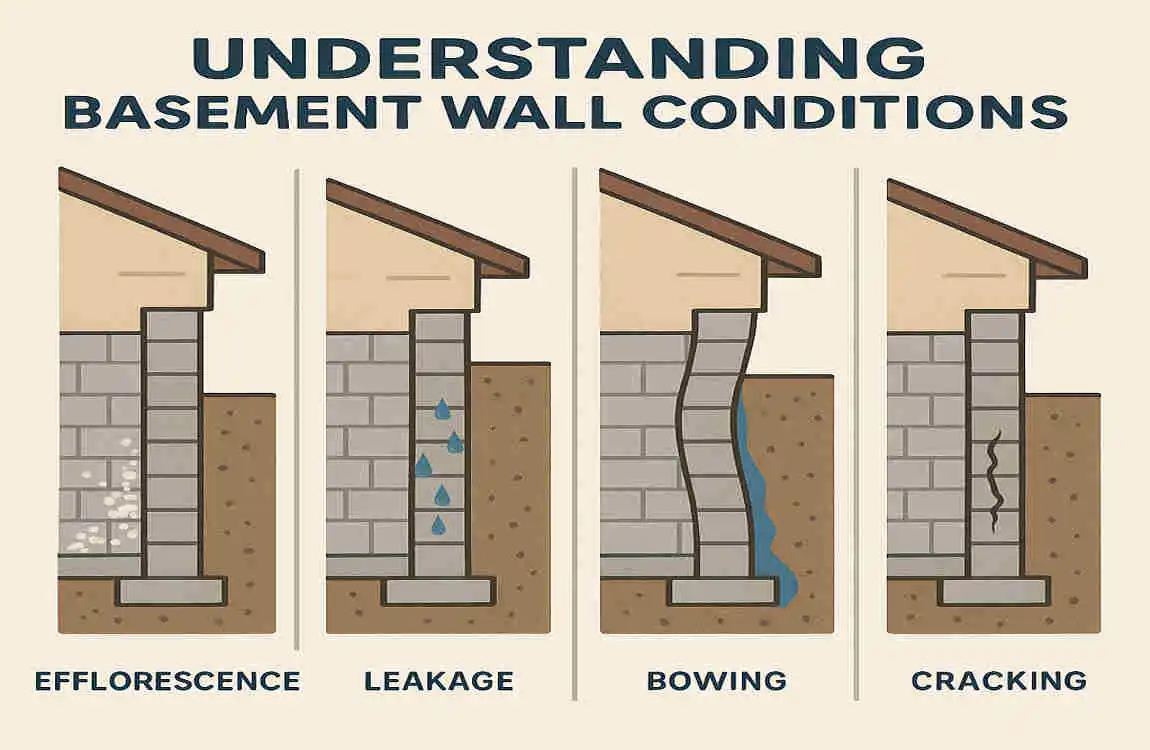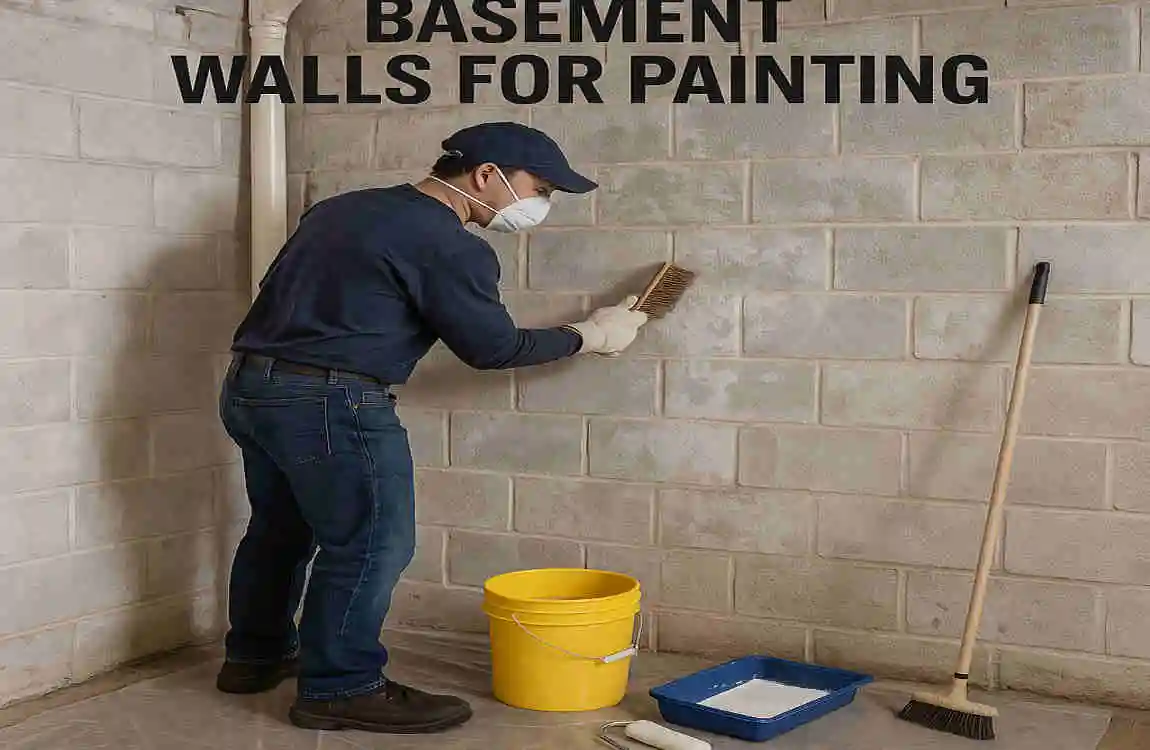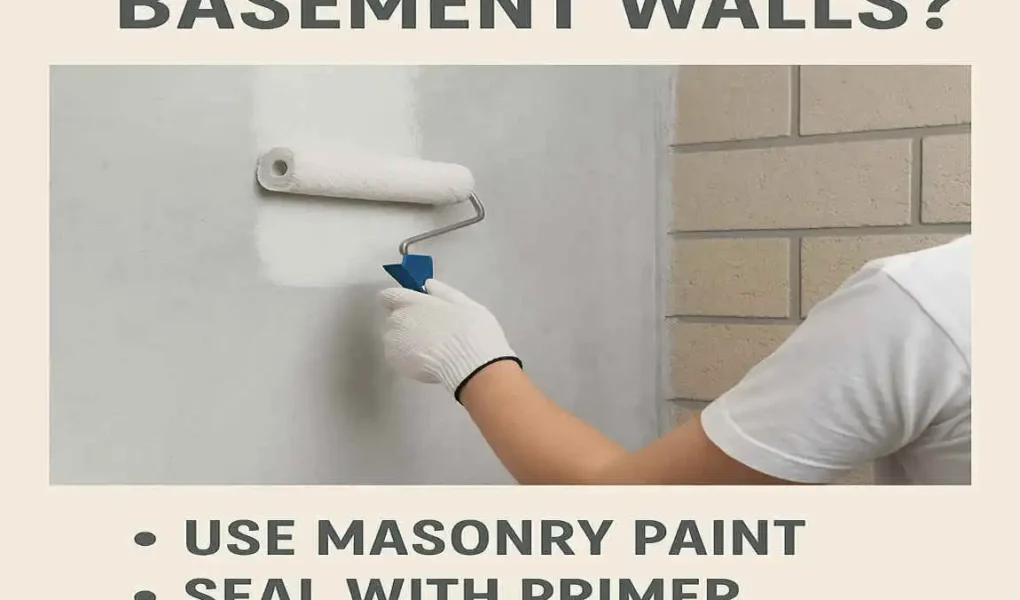Picture this: you’ve finally decided to transform your basement into a cozy retreat or a functional space. But as you begin the project, you’re faced with a common dilemma – what type of paint is best for basement walls? You’re not alone in this struggle. Basement walls present unique challenges due to their exposure to moisture and varying temperatures. Choosing the right paint is crucial to combat these issues and ensure a durable, moisture-proof finish.
Understanding Basement Wall Conditions

Before we jump into the world of paints, let’s take a moment to understand the unique conditions of basement walls. Basements are notorious for their dampness, moisture, and temperature fluctuations. These factors can wreak havoc on your paint job if not adequately addressed.
Common Basement Issues
Basements are prone to several issues that can impact the performance of your paint. Moisture is the biggest culprit, often leading to dampness, mold, and mildew growth. Temperature fluctuations can cause the walls to expand and contract, leading to cracking and peeling paint. It’s essential to address these issues before embarking on your painting project.
Types of Basement Wall Materials
Basement walls can be made of various materials, each with its own paint requirements. Concrete and brick walls are common in older homes, while drywall is often used in newer constructions. Understanding the type of material you’re working with will help you choose the right paint and preparation methods.
Environmental Factors and Paint Performance
The environment in your basement plays a significant role in how your paint performs. High humidity can cause paint to peel or blister, while low temperatures can slow drying. It’s crucial to consider these factors when selecting your paint and planning your project.
Why Regular Interior Paint Falls Short
You might be tempted to reach for a can of regular interior paint, but trust us, it’s not the best choice for your basement walls. Regular paint lacks the moisture resistance and durability needed to withstand the unique conditions of a basement. Investing in the correct type of paint will save you time, money, and frustration in the long run.
Key Qualities to Look For in Basement Wall Paint
Now that we’ve covered the challenges of painting basement walls, let’s explore the key qualities to look for in your paint. Keep these factors in mind as you navigate the world of basement wall paints.
Moisture Resistance and Waterproofing
The most critical quality to look for in basement wall paint is moisture resistance. Your paint should withstand the dampness and humidity common in basements. Look for paints with waterproofing properties to ensure a long-lasting finish.
Mold and Mildew Resistance
Mold and mildew are the bane of every basement owner’s existence. Choose a paint with mold- and mildew-resistant additives to prevent these pesky growths from taking hold on your walls.
Durability and Abrasion Resistance
Basement walls are often subject to wear and tear, especially if you use the space for storage or play. Opt for a paint that offers excellent durability and abrasion resistance to withstand the daily grind.
Breathability vs. Vapor Barrier Effectiveness
There’s a delicate balance between breathability and vapor barrier effectiveness when it comes to basement wall paint. Breathable paints allow moisture to escape, reducing the risk of peeling and blistering. However, in some cases, a vapor barrier may be necessary to prevent moisture from seeping through the walls. Consider your specific basement conditions when making this decision.
Ease of Application and Coverage
Let’s face it, nobody wants to spend hours upon hours painting their basement walls. Look for a paint that is easy to apply and provides good coverage. This will save you time and effort, allowing you to enjoy your newly painted space sooner.
Types of Finishes
The finish of your paint can significantly impact the overall look and feel of your basement. Matte finishes are great for hiding imperfections, while satin and semi-gloss finishes offer more durability and are easier to clean. Gloss finishes provide the highest level of durability and are ideal for high-traffic areas.
VOC Levels and Indoor Air Quality
Volatile organic compounds (VOCs) are chemicals found in many paints that can negatively impact indoor air quality. Opt for low-VOC or VOC-free paints to ensure a healthier environment in your basement.
Types of Paint Best Suited for Basement Walls
Now that we’ve covered the key qualities to look for in basement wall paint, let’s explore the types of paint best suited for your project. Each type has its own unique benefits and drawbacks, so it’s essential to choose the right one for your specific needs.
Elastomeric Paints
Elastomeric paints are a popular choice for basement walls due to their excellent resistance to cracking and their waterproofing properties. These paints are highly flexible, allowing them to expand and contract with the walls without cracking or peeling.
Benefits of Elastomeric Paints
- Excellent cracking resistance
- Superior waterproofing properties
- Highly flexible and durable
Ideal Use Cases for Elastomeric Paints
Elastomeric paints are ideal for basement walls prone to cracking from temperature fluctuations or settling. They’re also an excellent choice for walls exposed to high moisture levels, such as those near a sump pump or in a particularly damp basement.
Epoxy Paints
Epoxy paints are known for their exceptional durability and chemical resistance. These paints create a rigid, moisture-resistant barrier that can withstand the most challenging conditions in your basement.
Benefits of Epoxy Paints
- Unparalleled durability
- Excellent chemical resistance
- Superior moisture barrier qualities
When Epoxy is the Best Choice
Epoxy paints are the best choice for basement walls that are subjected to heavy wear and tear, such as those in a workshop or storage area. They’re also ideal for walls that are exposed to chemicals or high levels of moisture.
Masonry Paints
Masonry paints are specifically designed for use on concrete and brick surfaces, making them an excellent choice for many basement walls. These paints offer excellent moisture and weather resistance, ensuring a long-lasting finish.
Benefits of Masonry Paints
- Designed for concrete and brick surfaces
- Excellent moisture and weather resistance
- Durable and long-lasting
Ideal Use Cases for Masonry Paints
Masonry paints are ideal for concrete or brick basement walls. They’re particularly well-suited for walls that are exposed to high levels of moisture or extreme temperature fluctuations.
Acrylic Latex Paints
Acrylic latex paint is a popular choice for many home improvement projects, but it may not be the best option for your basement walls. While these paints offer good moisture management properties, they may not provide the durability and moisture resistance needed for a basement environment.
Pros and Cons of Acrylic Latex Paints
- Pros:
- Good moisture management properties
- Easy to apply and clean up
- Available in a wide range of colors and finishes
- Cons:
- May not provide sufficient durability for basement walls
- Lacks the moisture resistance of other paint types
Role in Moisture Management
Acrylic latex paints can help manage moisture in your basement by allowing it to escape through the paint film. However, they may not provide the level of moisture resistance needed for a damp basement environment.
Anti-mold and Anti-mildew Paints
Anti-mold and anti-mildew paints contain special additives and treatments that help prevent fungal growth on your basement walls. These paints are an excellent choice for basements prone to mold and mildew due to high moisture levels.
Special Additives and Treatments
Anti-mold and anti-mildew paints contain ingredients such as zinc oxide, titanium dioxide, and biocides that help prevent mold and mildew growth on your walls. These additives create an inhospitable environment for fungal growth, helping keep your basement walls clean and healthy.
Preventing Fungal Growth in Damp Basements
By choosing an anti-mold and anti-mildew paint for your basement walls, you can help prevent the growth of these pesky organisms. These paints work by creating a barrier that prevents moisture from penetrating the wall surface, reducing the likelihood of mold and mildew growth.
Comparison of Paint Types
To help you make an informed decision, here’s a table comparing the key features, durability, cost, and best use cases of each paint type:
Paint Type, Key Features, Durability, Cost, Best Use Cases
Elastomeric Cracking resistance, waterproofing, and flexibility. High Moderate to high Cracking walls, high moisture areas
Epoxy Durability, chemical resistance, and moisture barrier. Very high, High, Heavy wear and tear, chemical exposure
Masonry Moisture and weather resistance, designed for concrete and brick. High Moderate Concrete and brick walls, high moisture areas
Acrylic Latex Moisture management, easy application , Moderate , Low to moderate, General home improvement projects
Anti-mold and Anti-mildew Mold and mildew resistance, moisture barrier , High Moderate to high Damp basements prone to mold and mildew
Preparing Basement Walls for Painting

Now that you’ve chosen the perfect paint for your basement walls, it’s time to prepare the surface for a flawless finish. Proper preparation is key to ensuring a long-lasting, moisture-resistant paint job.
Surface Inspection and Repair
Before you begin painting, thoroughly inspect your basement walls. Look for any cracks, peeling old paint, or signs of efflorescence (a white, powdery substance that can form on concrete surfaces). Address these issues before painting to ensure a smooth, even finish.
Cleaning Methods
Cleaning your basement walls is essential to remove mold, dirt, and mildew. Use a solution of water and mild detergent to scrub the walls, paying special attention to any areas with visible growth. For stubborn mold or mildew, consider using a specialized cleaner or a bleach-and-water mixture.
Importance of a Quality Primer
A quality primer is crucial for achieving a durable, moisture-resistant paint job on your basement walls. Primers help create a strong bond between the paint and the wall surface, improving adhesion and longevity. Look for moisture-sealing primers or mold-resistant primers to address the unique challenges of a basement environment.
Choosing the Right Primer
When selecting a primer for your basement walls, consider the type of material you’re working with. For concrete and brick walls, a masonry primer is the best choice. Drywall walls may require a different kind of primer, such as a PVA primer or a specialized basement wall primer. Always follow the manufacturer’s recommendations for the best results.
Step-by-Step Preparation Process
To ensure a successful paint job, follow these steps to prepare your basement walls:
- Inspect and repair any cracks or damage: Use a patching compound to fill in any cracks or holes in the wall surface. Allow the compound to dry completely before proceeding.
- Remove old paint and efflorescence: Scrape off any peeling or flaking paint, and use a wire brush to remove any efflorescence from the surface. Rinse the walls thoroughly with clean water.
- Clean the walls: Use a solution of water and mild detergent to scrub the walls, removing any dirt, mold, or mildew. Rinse the walls thoroughly and allow them to dry completely.
- Apply a quality primer: Choose a moisture-sealing or mold-resistant primer that is appropriate for your wall material. Apply the primer according to the manufacturer’s instructions, using a brush or roller to ensure even coverage.
- Allow the primer to dry: Follow the manufacturer’s recommended drying time before applying paint to the primed surface.
By following these steps, you’ll create a clean, smooth surface that is ready for painting. Your paint will adhere better, and you’ll achieve a more durable, moisture-resistant finish.
Expert Tips for Applying Paint on Basement Walls
Now that your basement walls are adequately prepared, it’s time to start painting. Follow these expert tips to ensure a smooth, even finish that will stand the test of time.
Recommended Tools and Techniques
For the best results, use high-quality painting tools, such as a good brush and roller. A paint sprayer can also be an effective option for large areas, but be sure to follow the manufacturer’s instructions carefully.
When applying paint, use smooth, even strokes to avoid leaving brush marks or roller lines. Work in small sections, blending each section into the next to create a seamless finish.
Number of Coats and Drying Times
The number of coats you’ll need will depend on the type of paint you’re using and the color you’re applying. In general, two coats are recommended for most basement wall paints. Allow the first coat to dry completely before applying the second coat, following the manufacturer’s recommended drying time.
Environmental Conditions
The ideal environmental conditions for painting your basement walls are a temperature between 50°F and 85°F and a relative humidity below 85%. Avoid painting in extreme temperatures or high humidity, as this can affect the drying time and overall finish of your paint job.
Handling Tricky Spots and Corners
Basement walls often have tricky spots and corners that can be challenging to paint. Use a small brush to carefully paint these areas, taking care to avoid drips or runs. If necessary, use painter’s tape to create clean lines and protect adjacent surfaces.
Safety Tips
When painting in a confined basement space, prioritize safety. Ensure proper ventilation by opening windows or using fans to circulate air. Wear protective gear, such as gloves and a mask, to protect yourself from paint fumes and potential skin irritation.
Maintenance and Longevity of Painted Basement Walls
Once your basement walls are painted, it’s essential to maintain them properly to ensure their longevity. Follow these tips to keep your painted walls looking their best for years to come.
Inspecting for Moisture and Mold
Regularly inspect your painted basement walls for signs of moisture or mold growth. Look for any peeling or bubbling paint, as well as any visible mold or mildew. If you notice any issues, address them promptly to prevent further damage.
Cleaning and Upkeep
To keep your painted walls clean and fresh, use a mild detergent and water solution to gently scrub the surface. Avoid using harsh chemicals or abrasive cleaners, as these can damage the paint. Regular cleaning will help prevent dirt and grime buildup, extending the life of your paint job.
When to Consider Repainting or Touch-Ups
Over time, your painted basement walls may begin to show signs of wear and tear. If you notice any significant damage or discoloration, consider repainting or touch-ups. In general, basement walls may need repainting every 5-10 years, depending on the level of wear and moisture exposure.
Improving Basement Waterproofing
While paint can help protect your basement walls from moisture, it’s not a substitute for proper waterproofing. Consider using a dehumidifier to control humidity levels in your basement, and apply sealants to any cracks or gaps in the walls or floor. By addressing the root cause of moisture issues, you’ll help extend the life of your painted walls.
Common Mistakes to Avoid When Painting Basement Walls
To ensure a successful paint job on your basement walls, be sure to avoid these common mistakes:
- Using regular interior or exterior paint: Regular paint is not designed to withstand the unique conditions of a basement environment. Always choose a paint formulated explicitly for basement walls.
- Skipping primer or inadequate surface prep: Primer is essential for creating a strong bond between the paint and the wall surface. Skipping this step or failing to properly prepare the walls can lead to peeling, cracking, or bubbling paint.
- Painting over damp or moldy walls: Never paint over damp or moldy walls, as this will only trap the moisture and encourage further growth. Always address these issues before painting.
- Applying paint in improper environmental conditions: Painting in extreme temperatures or high humidity can affect the drying time and overall finish of your paint job. Always follow the manufacturer’s recommendations for ideal painting conditions.
- Overlooking ventilation and moisture control: Proper ventilation and moisture control are essential for a successful basement paint job. Ensure adequate airflow and consider a dehumidifier to control humidity.




